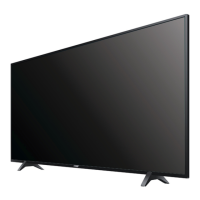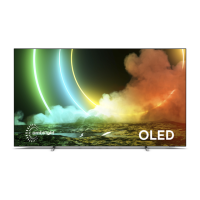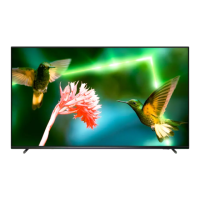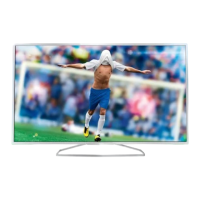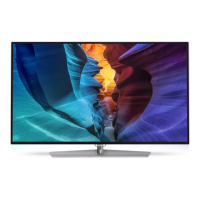
Do you have a question about the Philips 6703 Series and is the answer not in the manual?
| Display Technology | LED |
|---|---|
| HDR Support | HDR10, HLG |
| Smart TV | Yes |
| Operating System | SAPHI |
| Audio Output | 20W |
| USB Ports | 2 |
| Refresh Rate | 60 Hz |
| Bluetooth | No |
| Screen Size | 65 inches |
| Resolution | 4K Ultra HD (3840 x 2160) |
| Connectivity | Ethernet |
Locate your TV's model/serial numbers. Register for benefits and support.
Access built-in Help for diagnostics, instructions, and troubleshooting.
Find online support, FAQs, software updates, and manuals at philips.com/TVsupport.
Contact support for repair services. Avoid self-repair to prevent injury or damage.
Update TV software via Internet or USB for new features and fixes.
Check the current TV software version in Settings > Update software.
Instructions for battery replacement, cleaning, and overview of remote control buttons.
Ensure IR sensor is clear and use TV joystick for basic operations if remote is unavailable.
Read all safety instructions before using the TV. Refer to Help > User manual for details.
Tips on positioning the TV for optimal viewing and ventilation, including wall mounting guidelines.
Connect the power cable and plug it in. Understand standby mode behaviour.
Connect devices using high-quality ports. Connect antennas and satellite dishes.
Connect HDMI, Component, Composite, and Optical audio devices.
Connect mobile devices wirelessly using Wi-Fi Direct/Miracast or MHL.
Connect CAM modules for premium channels and use the Philips TV Remote App.
Connect USB Flash Drives and Hard Drives for viewing media or recording.
Switch between connected devices and rename device icons.
Watch, switch, and install channels via Antenna/Cable. Understand channel icons.
Create, edit, remove, search, filter, lock channels, and manage favourite lists.
Search, update, and reinstall satellite channels. Configure satellite settings.
Manage channel lists, copy lists via USB, and adjust channel options.
Access Teletext pages, subtitles from text, and text sub-pages.
Configure text options like freeze page, dual screen, and set preferred text language.
Open, navigate, view details, set reminders, and search for programmes.
Schedule programme recordings and access catch-up TV via Freeview Play.
Record digital broadcasts and schedule recordings. Understand DRM restrictions.
Pause and resume live TV broadcasts using a connected USB Hard Drive.
View photos, start slideshows, play videos, and access media options.
Play music files and access music playback options.
Navigate the Home menu for Sources, Apps, Search, and Settings.
Adjust picture styles, colour, contrast, sharpness, and sound settings.
Fine-tune picture format, motion styles, and advanced sound options.
Configure Ultra HD signals and manage TV energy saving features.
Set TV language, menu language, audio preference, and clock settings.
Enable accessibility features and set child lock PIN codes and parental ratings.
Connect your TV to a home network wirelessly or via a wired connection.
View network details, manage Wi-Fi, configure static IP, and clear internet memory.
Configure Smart TV, access the start page, and browse the App Gallery.
Watch missed TV programmes or rent movies online.
Select Ambilight behaviour: Follow Video, Audio, Colour, Flag, or App.
Adjust brightness, saturation, and use Ambilight as room light.
Configure Hue bulbs to synchronize with Ambilight for enhanced lighting effects.
Adjust wall colour influence and TV switch-off behaviour for Ambilight.
Information on product energy efficiency class and consumption values.
Instructions for responsible disposal of old products and batteries.
Details on power, reception inputs, and display resolution.
List of supported video input resolutions for HDMI and Composite.
List of supported PC input resolutions and refresh rates.
Details on sound output, Dolby Audio, DTS-HD, and supported media formats.
General tips for finding solutions and accessing Philips support resources.
Troubleshoot TV not switching on, no channels, or satellite detection problems.
Troubleshoot no picture, distorted picture, no sound, or poor sound quality.
Troubleshoot HDMI, USB playback, Wi-Fi, Internet, and menu language problems.
Read all safety instructions to prevent electric shock, fire, injury, and damage.
Guidelines for cleaning the TV screen and frame safely.
Information on open source software used and how to obtain source code and licenses.


